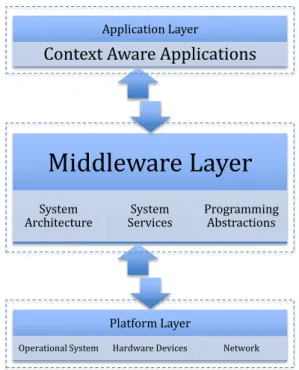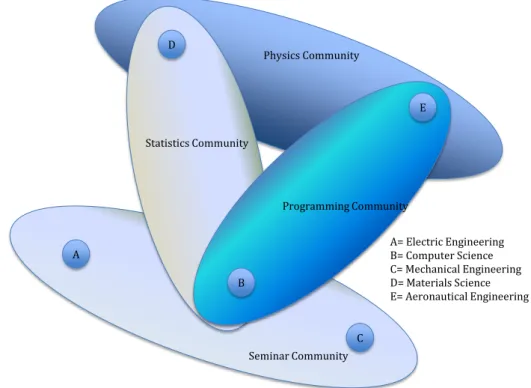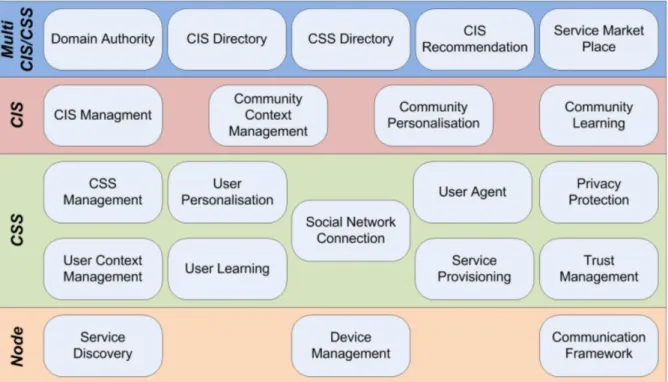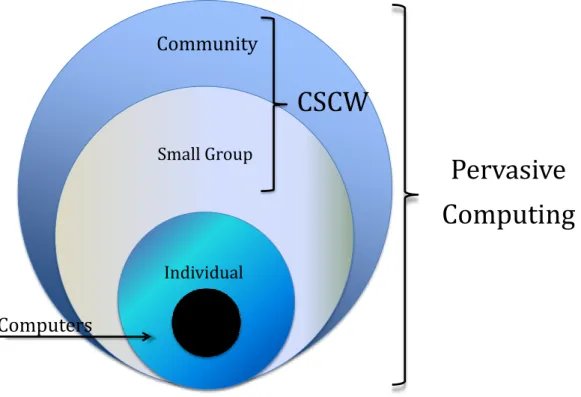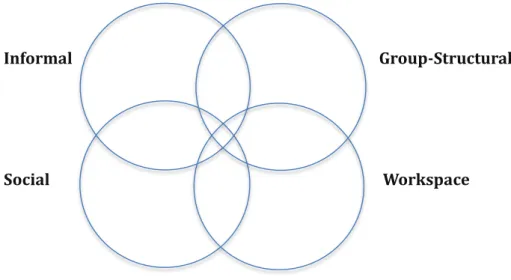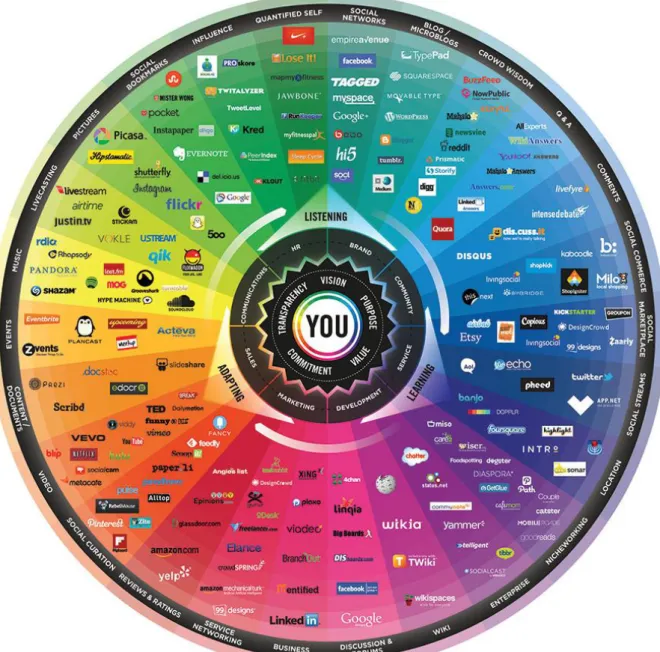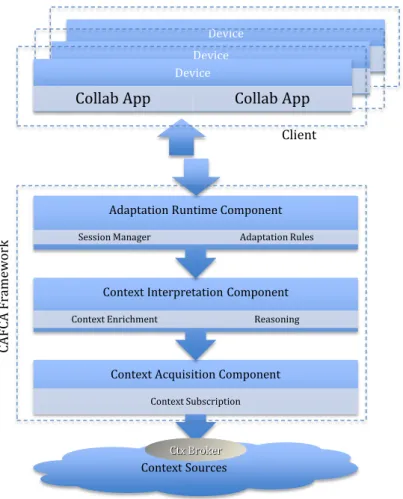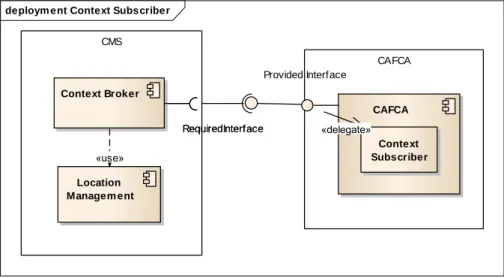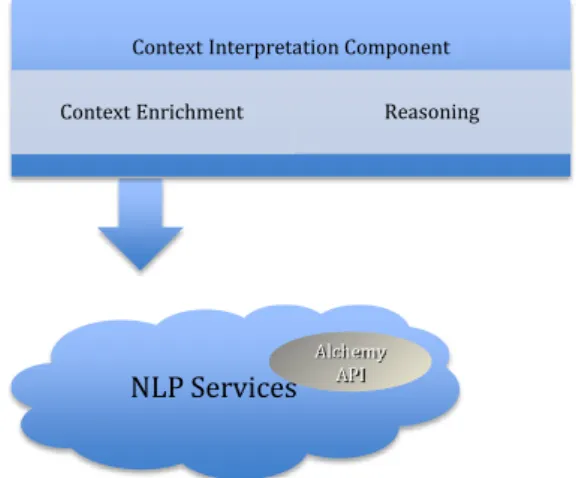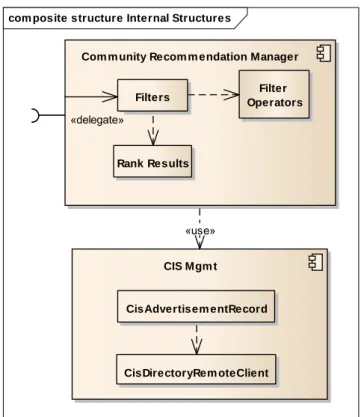Contents
1 INTRODUCTION ... 1 1.1 MOTIVATION ... 2 1.2 CONTRIBUTION ... 3 1.3 PUBLICATIONS ... 4 1.3.1 Journal Publications ... 41.3.2 Conference and Workshop Publications ... 4
1.4 THESIS ORGANIZATION ... 4
2 PERVASIVE COMPUTING ... 7
2.1 INTRODUCTION AND MOTIVATION ... 7
2.2 CONTEXT-AWARENESS ... 8
2.3 CONTEXT MANAGEMENT SYSTEMS ... 9
2.4 SMART SPACES AND MOBILITY ... 11
2.4.1 Operational systems/Platform layer... 12
2.4.2 Middleware layer ... 12
2.4.3 Application layer ... 14
2.4.4 Context Aware Applications ... 14
2.5 CONTEXT INFORMATION IN GROUPS ... 15
2.6 PERVASIVE COMMUNITIES ... 16
2.7 MOTIVATING SCENARIOS IN ENTERPRISE DOMAIN ... 19
2.7.1 Newspaper Scenario ... 20
2.7.2 Health Scenario ... 21
2.8 SCENARIOS REQUIREMENTS ... 22
2.9 CONCLUSIONS ... 25
3 COMPUTER SUPPORTED COOPERATIVE WORK... 27
3.1 INTRODUCTION ... 27
3.2 GROUPWARE ... 29
3.2.1 Asynchronous and Synchronous Communication ... 31
3.2.2 Coordination ... 31
3.3 SOCIAL ASPECTS IN CSCW ... 32
3.4 AWARENESS IN COLLABORATION ... 34
3.4.1 Awareness in different domains ... 36
3.5 3CCLASSIFICATION OF SUPPORTED FUNCTIONS... 37
3.6 CONTEXT-AWARENESS IN CSCW ... 38 3.7 COLLABORATION ENVIRONMENTS ... 39 3.8 CONCLUSIONS ... 40 4 SOCIAL COMPUTING ... 43 4.1 INTRODUCTION ... 43 4.2 SOCIAL CAPITAL... 44
4.3 COMMUNITIES OF PRACTICE AND INTERESTS ... 44
4.4 SOCIAL COMPUTING CLASSIFICATION ... 45
4.7 MOBILE SOCIAL SOFTWARE ... 49
4.8 SOCIALLY AWARE COMPUTING ... 50
4.9 SOCIAL NETWORK ANALYSIS ... 50
4.9.1 Relations and Tie Strength ... 52
4.9.2 Clustering and Similarities... 53
4.9.3 Groups and Small Groups Analysis ... 53
4.10 DYNAMIC SOCIAL NETWORK ANALYSIS ... 54
4.11 CONCLUSIONS ... 55
5 CAFCA: DESIGN AND IMPLEMENTATION ... 57
5.1 INTRODUCTION ... 57
5.2 REQUIREMENTS ANALYSIS ... 58
5.2.1 Functional Requirements ... 58
5.2.2 Non-Functional Requirements ... 59
5.3 FRAMEWORK ARCHITECTURE ... 60
5.4 CONTEXT ACQUISITION COMPONENT ... 61
5.4.1 Context Subscription ... 61
5.5 CONTEXT INTERPRETATION COMPONENT ... 63
5.5.1 Context Enrichment ... 64
5.5.2 Reasoning ... 65
5.6 ADAPTATION RUNTIME COMPONENT ... 67
5.6.1 Session Manager ... 67
5.6.2 Integration of Collaborative Applications ... 69
5.6.3 Rule Engine ... 70
5.6.4 Adaptation Rules ... 73
5.7 COMPARISON WITH RELATED WORK ... 74
5.8 DESIGN FOR COMMUNITIES RECOMMENDATIONS... 76
5.9 CONCLUSIONS ... 78
6 TESTING AND EVALUATION ... 79
6.1 INTRODUCTION ... 79
6.2 ENTERPRISE STUDY CASE ... 80
6.2.1 Enterprise Group Questionnaire ... 81
6.3 CAFCASTANDALONE TRIAL ... 86
6.3.1 Participants ... 86
6.3.2 Pre-Questionnaire ... 87
6.3.3 User Trial Procedure ... 90
6.3.4 Instructions to the group ... 93
6.3.5 Pilot Trial ... 94
6.3.6 User Trial ... 94
6.3.7 Post-Questionnaire ... 98
6.3.8 Results and Discussion of the User Trial ... 101
6.4 PERFORMANCE BASED ON THE CONTEXT INFORMATION ... 102
6.5 CONCLUSIONS ... 103
7 CONCLUSIONS ... 105
9 APPENDIX A: PRE-QUESTIONNAIRE ... 125
10 APPENDIX B: POST-QUESTIONNAIRE ... 129
List of Figures
Figure 2.1: The invariant characteristics of context. Adapted from (Sandkuhl and
Borchardt (2014). ... 9
Figure 2.2: (a) Centralized and (b) distributed architecture for CMS (Chihani, 2013). ... 10
Figure 2.3: Architecture Middleware for Smart Spaces. ... 12
Figure 2.4: Five Communities of Smart Spaces to form four communities ... 17
Figure 2.5: Cooperating Smart Space layered functional architecture (Doolin et al., 2014). ... 18
Figure 3.1: Interactions among the parts for CSCW and pervasive computing ... 33
Figure 3.2: Types of awareness according to Guwin et al. (1996). ... 35
Figure 3.3: Classification of collaborative applications based on 3C model (Borghoff and Schlichter, 2000). ... 37
Figure 4.1: The conversation prism V4.0 by Brian Solis & JESS3. ... 47
Figure 4.2 Social Software Triangle (Koch, 2008). ... 48
Figure 5.1: CAFCA Framework high-level architecture ... 60
Figure 5.2: Context subscriber component diagram. ... 62
Figure 5.3: Short-term context information in the graph database ... 64
Figure 5.4: Long-term context information in the graph database ... 64
Figure 5.5: Context enrichment subcomponent integrated with an external NLP sources ... 65
Figure 5.6: Auto-threshold algorithm. ... 67
Figure 5.7: Screenshot of collaborative sessions on administrator’s page... 68
Figure 5.8: Long-term context information in the graph database ... 68
Figure 5.9: Screenshot of rules on the administrator page. ... 72
Figure 5.10: Community Recommendation Manager Component. ... 77
Figure 6.1: Daily use of features and sensors integrated in devices. ... 82
Figure 6.2: Social media usage. ... 83
Figure 6.3: Usage of Social Networking Sites, Blogging sites and Instant Messaging applications ... 83
Figure 6.4: Type of activities that social media are used ... 84
Figure 6.5: Significant criteria in order to join a new group ... 85
Figure 6.6: Ranked conference objectives ... 85
Figure 6.7: Professional interests of participants ... 87
Figure 6.8: Frequency of professional information shared over SNS by the participants. ... 89
Figure 6.10: Setup used in the user trial. ... 91
Figure 6.11: Privacy policies of a community on an Android device. ... 92
Figure 6.12: Screenshot on the left shows a user profile example. On the right, an invitation to join a chat room... 93
Figure 6.13: Priority groups with context enrichment. ... 95
Figure 6.14: Priority groups without context enrichment. ... 96
Figure 6.15: Relevance groups with context enrichment. ... 97
Figure 6.16: Relevance groups without context enrichment. ... 97
Figure 6.17: Acceptance of suggestions made by priority mode. ... 98
Figure 6.18: Acceptance of suggestions made by relevance mode. ... 98
Figure 6.19: Feedback from participants about both stages of evaluation. ... 99
Figure 10.1: Collaborative applications integration class diagram. ... 131
Figure 10.2: Rule engine and rule class diagrams. ... 132
List of Tables
Table 2.1: Features and Challenges of Newspaper Scenario ... 23
Table 2.2: Features and Challenges of Health Scenario ... 24
Table 3.1: Time/Space Matrix (Johansen, 1988) ... 28
Table 3.2: Terminology for phenomena at the individual, small group and community levels of description. Partially adapted from (Stahl, 2011) ... 34
Table 4.1: Suggested classification of social computing (Lugano, 2012) ... 46
Table 4.2: Types of network studies (Borgatti et al., 2013) ... 52
Table 5.1: Comparison table of the frameworks ... 75
Table 6.1: Participants that use specific devices to perform the listed activities ... 82
Table 6.2: Matrix of persons that have the same work routines from respondent point of view. ... 88
Table 6.3: Matrix of people that work together from respondent point of view. ... 88
Table 6.4: Matrix of degree of similarity based on their professional interests and work practices. ... 89
Table 6.5: Feedback from participants about both stages of evaluation. ... 100
Table 6.6: Participants who believe it is useful suggestions to suggest participate in groups with common interests. ... 100
Table 6.7: Priority Mode ... 102
Acronyms
AmI Ambient Intelligence
API Application Programming Interface
CAA Context-Aware Application
CAFCA Context-Aware Framework for Collaborative Application
CAS Complex Adaptive Systems
CB Context Broker
CIS Community Interaction Space
CMC Computer-mediated Communication
CMS Content Management System
CoI Communities of Interests
CoP Communities of Practice
CSS Cooperating Smart Space
CxC Context Consumer
CxP Context Provider
CORBA Common Object Request Broker Architecture
CSCW Computer Supported Cooperative Work
CSCL Computer Supported Collaborative Learning
DSN Dynamic Social Networks
DSNA Dynamic Social Networks Analysis
DSNS Decentralised Social Networking Systems
IM Instant Message
IRC Internet Relay Chat
MAS Multi-Agent System
MoSoSo Mobile Social Software
MSN Mobile Social Networking
OS Operational System
OSGi Open Services Gateway Initiative
OWL Web Ontology Language
P2P Peer-to-Peer
PDA Personal Digital Assistant
RMI Remote Method Invocation
SIP Session Initiation Protocol
SNA Social Network Analysis
SNS Social Network Service
SOA Service Oriented Architecture
W3C World Wide Web Consortium
WebRTC Web Real-Time Communication
Wi-Fi Wireless Fidelity
XML eXtensible Markup Language
1 I
NTRODUCTION
With the growing adoption of mobile and pervasive devices, there is an increasing de-mand of applications with self-adaptive behaviours using social and environment in-formation. These characteristics can provide better end-user experience, not only in home and entertainment places, but also in collaborative work situations.
To date, Ambient Intelligence (AmI) has achieved a matured level, thanks to the advance of the technology, mainly by sensors and mobile devices carried by users (Wang et al., 2004). Typically, context information in pervasive environments can be retrieved in a variety of ways such as physical sensors, network information, user pro-files and other sources. Context information refers to a set of conditions (e.g. environ-ment features, user activities, location) that may be utilized by applications in order to adapt dynamically their behaviour. Environments such as smart spaces are aware of context such as location/proximity (e.g. home, office) and environment features (e.g. hot, cold) enabling users to access computing resources to perform their activities. By combining smart spaces with social computing, it is possible to create a pervasive envi-ronment in which social information can be used as context information. In addition, the increasing usage of portable devices can be exploited to create rich applications involv-ing adaptability without explicit user intervention, takinvolv-ing into account environmental context.
Activities in smart spaces may involve multiple users collaborating on shared tasks. Computer Supported Cooperative Work (CSCW) studies the cooperative work among individuals and addresses various applications for collaboration, ranging from conference to workflow environments. The CSCW area is not new, but only recently, research in context-aware CSCW applications reached pervasive systems. Additionally, the trend is the use of collective intelligence, where interpretation of context infor-mation related to social relationships should be harnessed as input for such collabora-tive applications. In this manner, combining pervasive systems and groups with
collabo-rative context-aware applications can increase the activity’s quality for the end user in a wide variety of tasks.
1.1 Motivation
With the advent of Web 2.0, various social networking sites have emerged in the
pre-sent scenario of the Internet like Facebook1, Google Plus2 and LinkedIn3. The
infor-mation provided by these social sites can be useful for pervasive or ubiquitous systems, where the change of environment and context are important to offer powerful ways of working and communicating.
Community support is gaining more importance, especially in areas where inter-human communication is a critical success factor (Koch et al., 2014). Communities in this case refer to a social unit, both to physical and virtual, that share common objec-tives. According to Grundin and Poltrock (2012), when people collaborate, they do so in the context of small groups or teams, organizations, or large-scale communities. How-ever, there are differences among these social structures to achieve common goals. For instance, while small groups rely in working together in real time, communities have higher need for coordination. In this way, the concepts of small groups and communities of practice facilitate opportunistic collaborations taking advantage of social awareness.
Until recently, social network analysis of complex and unknown relationships were hard to achieve and only performed off-line (Chung et al., 2006). This means that data collected over a period could only be analysed after its collection, especially in sce-narios where nodes may appear and disappear and edges may tie or untie. Neverthe-less, today’s technologies make it possible to build a solution with ability to adapt to constantly changing physical and social contexts, providing users with a unique experi-ence for collaborations. Social context refers to the information relevant to the charac-terization of a situation that influences the interactions of users.
Relying on social networks analysis with the concepts of social capital, small groups and communities of practice it is potential to determine temporary social groups, based on user context information, physical location, and co-presence. This way, CSCW applications, combined with social computing and context-awareness, can bring great benefits for smart spaces participants’ experience. As such, pervasive and social computing are central points to the development of systems for the future collaborative applications. All these aspects present new challenges for solutions in context-aware CSCW applications.
1 https://www.facebook.com/ 2 https://plus.google.com/ 3 https://www.linkedin.com
1.2 Contribution
The goal of this PhD thesis is to demonstrate that CSCW applications can benefit from using context information merged with social computing in pervasive environments. In order to provide better and efficient collaboration among users, a Context-Aware Framework for Collaborative Applications (CAFCA) was designed and implemented. This is approached within pervasive communities, where each community shares in-formation that can be combined in context-aware applications. This involves the use of context information and social context to provide context-awareness for collaborative applications, enhancing the experience of the participants in cooperative tasks.
The author participated in European projects PERSIST (Personal Self Improving Smart Spaces) and SOCIETIES (Self-Orchestrating CommunIty ambiEnT Intelligence Spaces), which enabled him the possibility to be involved with pervasive computing and context-awareness. The code developed under the Thesis was released to the public under Open Source License for public usage.
The contributions of this thesis are:
Design and implementation of a context-aware framework for collaborative
work aiming pervasive environments, enabling dynamic use of context and social information facilitating group formations (see Chapter 5). Published in Lima et al. (2014);
Provide pro-active behaviour for communication, coordination and
relation-ships in pervasive community scenarios for CSCW (see Chapter 5). Published in Lima et al. (2012).
Verify the synergy among the intersecting research areas of pervasive
compu-ting, CSCW and social computing. Published in Lima et al. (2012).
Provide a social matching mechanism capable to find participants based on
the context information provided from the environment and user social con-text (see Chapter 6). Published in Lima et al. (2013a);
Take advantage of context information available of social network sites such
as Facebook, LinkedIn and real-world sensing sources to aggregate the con-text information to the user (see Chapter 6);
Support the increment of existing context information by Natural Language
Processing and semantic analyse (see subsection 5.5.1). Published in Lima et al. (2013b);
Provide real-time adaptation of collaborative tools for collocated and
non-collocated teams in order to facilitate users’ interactions in response to con-text information changes (see subsection 5.6.3);
Facilitate the integration of existing collaboration tools to offer context
awareness, adaptability and coordination, aiming to reduce human interac-tions (see subsection 5.6.2). Published in Gomes et al. (2011);
Support the election of appropriate application for communication based on the communication channels available from the users (see Chapter 5);
Evaluate and test the proposed implementation in user trial for proof of
con-cept and feedback (see Chapter 6);
1.3 Publications
1.3.1 Journal Publications
Christopher V. Lima, Mário Antunes, Diogo Gomes, Rui L. Aguiar, Telma
Mo-ta, "A Context-Aware Framework for Collaborative Activities in Pervasive Communities", International Journal of Distributed Systems and Technologies, vol. 5, no. 2, pp. 31–43, IGI Global Publishing, July 2014.
Roberta Lima-Gomes, Guillermo de Jesus Rivera, Roberto Willrich, Christopher
V. Lima, Jean-Pierre Courtiat, "A Loosely Coupled Integration Environment for Collaborative Applications", IEEE Transactions on Systems, Man, and Cyber-netics - Part A: Systems and Humans, vol. 41, no. 5, pp. 905–916, September 2011.
1.3.2 Conference and Workshop Publications
Christopher V. Lima, Mário Antunes, Diogo Gomes, Rui L. Aguiar, "A
Context-Aware Framework For CSCW Applications In Enterprise Environments" in Proceedings of the IADIS International Conference Web Based Communities and Social Media 2013, Proceedings of the IADIS International Conference Col-laborative Technologies 2013, Czech Republic, pp. 11–18, July 2013,
Christopher V. Lima, Mário Antunes, Diogo Gomes, Rui L. Aguiar, "Social
Awareness in Pervasive Communities for Collaborative Work" In Intelligent Environments Workshops, volume 17 of Ambient Intelligence and Smart Envi-ronments, Greece, pp. 110 – 115, July 2013.
Christopher V. Lima, Diogo Gomes, Rui L. Aguiar, "Pervasive CSCW for Smart
Spaces Communities", 9th IEEE International Workshop on Managing Ubiqui-tous Communications and Services, pp. 118–123, Switzerland, February 2012.
1.4 Thesis Organization
The thesis is organized in two parts. The first part reviews essential domains to the work. Chapter 2 starts with an overview of the pervasive computing, introducing con-text-aware and pervasive communities. Chapter 3 identifies opportunities and challeng-es for CSCW. Chapter 4 focus on social computing dchalleng-escribing social capital, communitichalleng-es of practices, Web 2.0 and social network analysis. This chapter also present the tech-niques used to provide support to CAFCA framework, including general cohort analysis, data analysis applied to social networks.
The second part presents the main thesis contribution with the design, implemen-tation and evaluation of the proposed solution. Chapter 5 introduces the CAFCA frame-work, presenting the design concept, implementation and technical aspects of the pro-posal solution. In Chapter 6, it is discussed a case study conducted with the proof-of-concept implementation to validate the framework and challenges in the evaluation.
Finally, Chapter 7 presents general conclusions and implications of this thesis. The chapter also discuss further work directions and extensions.
In the Appendix A and B are presented the questionnaires used in the validation test in Chapter 6. Appendix C includes UML diagrams of CAFCA framework, as support to the work done in Chapter 5.
2 P
ERVASIVE
C
OMPUTING
This chapter presents the areas of pervasive and context-aware computing from the point of view of the thesis. The chapter also introduces solutions that underlie a majori-ty of pervasive computing application development. A set of future scenarios is present-ed covering different situations in enterprise domain to enable a better comprehension. These scenarios explain with practical examples the features and capabilities identified as requirements of the thesis.
2.1 Introduction and Motivation
Pervasive environments have evolved over the years, thanks to technology advances and decreasing prices in sensors and mobile devices (Want, 2010) . Moreover, the in-crease of consumer portable devices such as smartphone, tablets and smart watches are being also exploited in ambient intelligence (AmI) to create rich applications without explicit user intervention. AmI is used extensively in applications such as healthcare, home care, transportation and environmental monitoring (Al-Jaroodi et al., 2009). Envi-ronments in pervasive computing are aware of context, where location/proximity (e.g. home, office), activities (e.g. walking, driving) and environment features (e.g. hot, cold) provide sources of information to produce the applications. Mark Weiser’s (Weiser, 1991) definition for pervasive and ubiquitous computing is that “The most profound technologies are those that disappear. They weave themselves into the fabric of every-day life until they are indistinguishable from it”.
A fundamental challenge in pervasive computing has been to create systems that scale-up smart space infrastructures to support many users. In Genco and Sorce (2010), the authors describe pervasive systems to free users in which devices, networks and applications will all be seamlessly integrated and will cooperate in support of a world-wide-shared computing paradigm. Researchers have addressed both social and
human-computer interaction aspects in the field, as well as technical aspects such as communi-cation, interoperability, architectures and hardware design.
In pervasive computing, many projects address infrastructures for smart spaces and mobile users (Taylor et al., 2011). A popular definition for smart spaces is provided by Prehofer et al. (2007) as “A smart space is a multi-user, multi-device, dynamic inter-action environment that enhances a physical space by virtual services”. The goal of any smart environment is to release users from the tasks they usually perform to change their environment to suit their preferences and to access the available services. This objective is achieved by making the environment able to adapt itself to user needs, providing customized interfaces to the services available at each moment.
2.2 Context-Awareness
In Chen & Kotz (2000), context-aware or context information is defines as the paradigm of pervasive computing that allows applications to discover and take advantage of con-textual information. Context may vary depending on application functionality, user goals and deployment environment. Schilit et al. (1994) were one the first to discuss context-aware computing, defining three important aspects: where you are, who you are with and what resources are nearby. Most cited definition for context is given by Abowd et al. (1999): “Any information that can be used to characterize the situation of an entity. An entity is a person, place, or object that is considered relevant to the inter-action between a user and an application, including the user and applications them-selves.” Consequently, having a common definition of context is a challenging issue. Fur-thermore, sociological approaches typically regard context as networks of interacting entities (people, agents and artefacts) created and continually updated by the interac-tions among them (Zacarias et al., 2010).
A popular way of classification for context instances is given in literature (Gustavsen, 2002; Prekop and Burnett, 2003). These proposals divided context in inter-nal and exterinter-nal. The interinter-nal dimension is specified by the user or captured by moni-toring user interactions such as user’s goals, tasks and emotional state. While the exter-nal dimension denotes the physical context, in which includes, for instance, location, touch, temperature and sound.
Figure 2.1 identifies invariant characteristics of the context for development of context-aware systems. These characteristics are (a) context relates always to some entity, (b) is used to solve a problem (c) depends on the domain and (d) is a dynamic process (Mena et al., 2007; Sandkuhl and Borchardt, 2014).
Figure 2.1: The invariant characteristics of context. Adapted from (Sandkuhl and Borchardt (2014).
In order to support these characteristics, it is common the use of an integrated solution for management of context information. Next section presents in details con-text management systems.
2.3 Context Management Systems
A Context Management System (CMS) provides the means to receive context infor-mation and apply the inforinfor-mation to build context-aware applications. Most of CMS rely on a centralized approach similar to Context Broker Architecture (CoBrA) (Chen et al., 2003). Context-aware systems can be designed taking into account different criteria (architecture, resource discovery, sensing, context model, context processing historical context data, security and privacy) and depend on requirements and conditions such as the location of sensors, amount of possible users and available resources (mobile phones or desktop PCs) (Baldauf et al., 2007).
A CMS is responsible for acquiring raw information from context sources and hardware sensors, modelling the collected data and maintaining the current and histor-ic context in appropriate data repositories. It is important to stress that some CMS can slightly change or even be optional like the history management, context data aggrega-tion and context reasoning. The components usually found in a CMS can be classified in four primary areas:
Context Acquisition: A prerequisite for context-aware applications, it refers to a
process of collecting contexts from various context sources. Contexts can be cap-tured through physical devices (e.g. sensors, accelerometers and agents) and vir-tual sources (e.g., software applications and services).
Context Storage: This component is responsible for the management of context
in-formation (i.e. retrieval, update, addition, removal).
Context Modelling: It is in charge to construct high-level abstraction of contextual
data and building relationships among them. Some models support querying not only current data, but also historical contextual information (Context History).
Domain Entity Dynamic Process Problem Context depends_on used_to_solve is_a relates_to
Context Reasoning: It is the process of deriving high-level contexts from raw con-text data and deriving implicit concon-texts from explicit concon-texts information.
Projects like Mobilife (Kernchen et al., 2006) and C-CAST (Knappmeyer et al., 2009) use a broker-based approach for CMS. In these cases, the CMS was responsible for storing and retrieving context information in a distributed manner. Both projects use a Context Broker (CB), a fundamental entity that creates and manages the relationship between Context Provider (CxP) and Context Consumer (CxC) (Chen, 2004). The CB is responsible for acquire context information on behalf of resource-limited devices, rea-son about context information, detect and resolve inconsistent context information, and even protect user privacy by enforcing policies that the users have defined (Zafar et al., 2009). The CxP is in charge of detecting and acquiring information from context sources (e.g. temperature, position), while the CxC is where the context is used (or consumed).
In a centralized architecture, a central point handles all the requests present be-tween the producers and consumers. In a distributed architecture, a point-to-point model is used, where each pair can be either a producer or a consumer. In some cases, the pair may play both roles (Chihani et al., 2011). Figure 2.2 illustrate a (a) centralized and a (b) distributed architecture for CMS.
Figure 2.2: (a) Centralized and (b) distributed architecture for CMS (Chihani, 2013).
Other CMS solutions also found in literature are: Gaia using Common Object Re-quest Broker Architecture (CORBA) as a distributed middleware for communication; and Service-oriented Context Aware Middleware (SOCAM) architecture using OSGi with context events represented in Web Ontology Language (OWL) based on a predefined ontology (Tao Gu et al., 2004).
CxC: Context Consumer CxP: Context Provider CxB: Context Broker CxB CxP/CxC CxP CxC CxP CxP CxP/CxC CxC CxP CxP/CxC CxP/CxC CxP/CxC CxC CxP CxP/CxC CxP/CxC CxP/CxC
2.4 Smart Spaces and Mobility
Smart spaces play an important role in pervasive computing, providing an environment where users can interact electronically with other users and devices in the environment. However, these systems did not take into account the mobility of the user as shown in projects as Ubisec (Groppe and Mueller, 2005), MavHome (Youngblood et al., 2005), or as in smart homes scenarios (De Silva et al., 2013). More recently, projects like Daidalos (Taylor et al., 2011) and PERSIST (Venezia et al., 2009) approached this challenge pro-posing the use of smart spaces specially associated with personal portable devices, ena-bling the availability of content anytime and anywhere.
Today with mobile devices containing numerous hardware and software capabili-ties, it is possible to create new smart spaces systems. This way, personal smart spaces try to tackle static smart spaces, without the need of infrastructure investment, and mo-bility to provide pervasive functionalities to the user all the time. Personal smart space systems generally include a context management system, discovery mechanisms, event notification, personal preferences, and cooperation between the entities. Personal smart spaces are defined as “a set of services that are running or available within a dynamic space of connectable devices where the set of services and devices are owned, con-trolled, or administered by a single user or organisation” (Gallacher et al. 2011).
The implementation of smart spaces requires software and hardware components to establish communication among users and resources, collecting information about users’ context, discovery, services, learning (users’ intentions), overall collecting data to plan and execute actions on the users’ behalf. Most current proposals for physical and logical mobility rely on the technique of middleware, which resides between the operat-ing system and the application layer. Middleware is a class of software design to support application development by enhancing the level of abstractions associated with the pro-gramming effort. In general, middleware provides basic services for upper layer appli-cations by providing programming interfaces and taking charge of management func-tions such as caching, fault tolerance and security (Yu et al., 2013). A number of mid-dleware technologies have been proposed to keep devices connected in a seamless way, allowing people to take advantage of pervasive systems. There are several middleware approaches applied in the design and development of smart spaces and recently the
researchers have been focusing in Web 2.01as a platform to provide new smart spaces
services (McFaddin et al., 2008; Prehofer et al., 2010).
While different aspects and purposes exist for middleware development, some are common for pervasive systems, equally encountered in projects such as Daidalos (Taylor et al., 2011), Gaia (Ziebart et al., 2005), Aura (Kumar et al., 2003) and One.World (Grimm et al., 2004). Based on Raychoudhury (2013), Yu et al. (2013) and Hong et al. (2009) we present a reference model consisting of three layers for middleware systems
concerning general issues, characteristics and the design of currently solutions. Figure 2.3 presents the architecture middleware for smart spaces.
Figure 2.3: Architecture Middleware for Smart Spaces.
2.4.1 Operational systems/Platform layer
Middleware systems are typically constructed on the top of the traditional operational systems (OS). However, there are particular cases in which the middleware present an OS developed specifically for this purpose (One.World, Gaia OS) (Grimm et al., 2001; Román et al., 2002). For most of smart spaces approaches, the use of small and/or mo-bile devices (e.g. tablet, smartphones and netbooks) is important since they provide sensors of acceleration, sound, light and location. Popular platforms for devices
devel-opment are Android2 and iOS3, depending on the type of the device. On the Linux family
platforms, the most adopted are Tizen4 and Android.
2.4.2 Middleware layer
The middleware layer can be subdivided in system architecture, system services and programming abstractions.
System architecture: In terms of system architecture, middleware design can adopt either top–down or bottom–up design depending on the system model and application 2 http://www.android.com/ 3 https://www.apple.com/ios/ 4 https://www.tizen.org/
Middleware Layer
SystemArchitecture ServicesSystem Programming Abstractions Application Layer
Context Aware Applications
Platform Layer
requirements. A top–down approach describes the system functionality at a very high level gradually refining the design at each step, until the detail is sufficient to allow cod-ing (e.g. Gaia, Aura and One.World). Within a bottom–up approach, the design process begins with several small parts and gradually composes them to build the whole system (e.g. PICO). Hybrid approaches are also used in the literature (e.g. PICO)
Additionally, the system architecture concentrates on the mode of system control and interaction among system components. The mode of system control can be either centralized or decentralized. In centralized control, a core component controls the de-vices and makes decisions on their behalf (e.g. Gaia, Aura and One.World). Consequent-ly, certain functions in the central entity are responsible for free resources in other enti-ties. However, centralized systems have a single point and consequently data is stored only in a central entity. In decentralized control, no device takes a final decision; in-stead, multiple devices work collaboratively in order to reach a global decision. As an example, CORTEX project used this approach (Biegel and Cahill, 2004).
In terms of interaction, systems depend on mostly in two communication mecha-nisms: messages passing and publish/subscribe (pub/sub). The message passing is a direct interaction paradigm, in which communication is made sending messages straight to the recipients (e.g. PICO, Gaia). On the other hand, publish/subscribe is an indirectly interaction, where the subscriber register for some events and asynchronous-ly receives messages (e.g. CORTEX, Aura).
System services: System services comprise the core functionalities of the pervasive middleware systems. The principal function is to provide support for application de-ployment and execution, including devices and network management. Common services include:
Communication management: responsible for providing abstract
interopera-bility among peers, devices and server;
Context management: responsible for contextual data acquisition, processing,
and derivation of higher-level contexts and context dissemination;
Service management: responsible for service discovery and service
composi-tion in AmI environments;
Security management: responsible for ensuring correct functioning of the
system and ensures protection of user information.
This way, system services provide implementations to achieve the abstractions of programming abstractions.
Programming abstractions: Programming abstractions define the interface of the middleware to the application programmer. The goal is to separate the development of the applications from the operations in the basic infrastructures. Three aspects are
in-volved in developing the programming abstractions: abstraction level, programming paradigm, and interface type.
The abstraction level refers to how the application programmer views the sys-tems, providing facilities to the development of applications. It can be based in node or system level approach. In the node level, the pervasive environment is abstracted as a distributed system consisting of a collection of heterogeneous computing devices, and provides programming support to individual devices in their actions and cooperation facilitating the development of applications with increased flexibility (e.g. Aura, COR-TEX). On the other hand, the system level abstracts the environment as a single virtual system, allowing the programmer to express a single centralized program into sub-programs that can execute on local nodes facilitating the abstraction of the nodes be-haviour (e.g. Gaia, One.World).
The programming paradigm refers to the model of programming the applications. They are divided into context-based, component-based and decentralized interaction based. In the context-based model, triggering events take place through context changes (e.g. One.World). For the component-based model, the application is composed of sev-eral component modules (e.g. Aura, Gaia). Finally, the decentralized interaction-based model uses multiple programmable smart entities interacting using some rules (e.g. CORTEX).
Finally, interface type, refers to the style of the Application Programming Interface (API). In fact, programming abstraction is embodied in the programming interface. Per-vasive applications require different programming interfaces based on the underlying system architecture and functionalities (e.g. discovery, communication, events).
2.4.3 Application layer
In this layer is where the reactions to context changes are implemented. The client plication is implemented on top of the middleware layer providing the users with ap-propriated solution in terms of environment such as home, hospital, classroom, etc. The crucial challenge for developers is to implement applications that continuously adapt to highly dynamic environments and continue to function even if people move through the physical world (Grimm et al., 2004). More details about context-aware applications are presented in the next section.
2.4.4 Context Aware Applications
The development of context-aware applications is supported by the use of context man-agement systems that implement different operations. This support is provided through exposing functionalities (e.g., via API) that can be invoked by applications. In Chen (2003) they separate context-aware applications (CAA) in active and passive. Active context-awareness comprises applications that change according to the discovered
con-text. On the other hand, passive context-awareness comprises applications that present new or updated context to the user, letting him choose to utilize this information in dif-ferent ways. To be able to understand the operational aspects of CAA, it is important to analyse the existing applications on the different domains (Chihani et al., 2011). The following is a limited list of CAAs taken from different domains related to the thesis sub-jects:
Location-Based Services: it is one of the most developed application type
nowa-days (e.g. Foursquare). The idea is assist people to locate their friends and inter-esting places for visiting or where meet friends.
Context-Aware Communication: this type of applications applies knowledge of
people's context to reduce communication barriers. Most scenarios are based on non-verbal and electronic communication services (e.g. SMS, chats and e-mail)
Context-Aware Recommendation Systems: aim to recommend a service or product
to a user based on his context. It is also identified as recommender systems, which combines collected data from users (about products rating, preferences, etc.) to predict the most relevant product or service to a user or a group.
Essentially, the goal is to provide applications that meet user expectations by ac-tions/suggestions that an application should apply in a given situation.
2.5 Context Information in Groups
According to Kalatzis et al. (2013), group context information in pervasive systems is not new, as the first approaches have been discussed as early as the year 2000. Group context involves all the knowledge relating to the group, including group composition, rules, roles, goals, strategies, coordination procedures (Brézillon et al., 2004). Conse-quently, a step towards this integration is the employment of group or community con-text awareness.
Recently, Schuster et al. (2013) recognized the importance of the existence of a taxonomy, introducing a classification to pervasive social context along the dimensions of space, time, people, and information source. It is important to take into account not only the characteristics of the group, but each participant as well. In Kalatzis et al. (2014) they propose a middleware to manage user and community context throughout the entire life cycle of context data. In any case, the heterogeneity of context data com-bined with the introduction of group context information increases the complexity of processing data in terms of storage, modelling and reasoning.
Research on context aware systems capable of support dynamic community man-agement in large scale is still in initial stages. While research efforts have been conduct-ed on a group context, support for conflict resolution context, or for inheritance of con-text information across hierarchical communities is still a challenging task.
2.6 Pervasive Communities
According to Wenger (2002), a community is spontaneously built and legitimizes vari-ous degrees of participation of (new) people based on its internal rules. The degree of participation of a person or actor is proportional to its distance to the centre of the community, physical and/or logical (Cabitza et al., 2006). In pervasive computing realm, this assumption requires technologies able to recognize and support participation of its users in the different kinds of grouping living in its space.
Social awareness plays an important role in order to create a group of users that cooperates effectively and successfully, especially in a smart space (Wang et al., 2010). Considering this, pervasive systems and smart spaces should enable users to create static groups of interest to share common goals and tasks or even take part in dynamic groups. Dynamic groups allow membership through suggestions to the user, based on criteria specified by a given particular community (Taylor, 2013).
Several criteria can be employed to form a community of individuals or organiza-tions, such as sharing same geographic location, having same or similar preferences, sharing some interest or share forms of social relationships. People with shared criteria may belong to a common community of smart space or group. The criterion to join a community can be given by automatic or manual fashion, depending on the user’s pref-erences. Figure 2.4 illustrates a set of smart spaces A, B, C, D and E sharing some specific criterion, forming four new communities. For instance in an educational scenario of E-learning, each community can represent students in different undergraduate programs but attending same courses (e.g. seminar). These communities enable individuals to advertise skills to their groups based on expertise levels or research areas in common. With all the formed groups, it is possible to apply communication and interaction mech-anisms with CSCW solutions.
Figure 2.4: Five Communities of Smart Spaces to form four communities Grouping individuals have always been a subject of study in CSCW (Computer Supported Cooperative Work) and Social Computing fields. In Rheingold (1993), he de-fines the term virtual community as “social aggregations that emerge from the Internet when enough people carry on those public discussions long enough, with sufficient hu-man feeling, to form webs of personal relationships in cyberspace”. This concept is translated to smart spaces as a group of people who share an interest, a craft, and/or a profession. People who participate in such communities learn the accepted work prac-tices, interact with each other and can become more productive.
Most studies approaching groups in pervasive environments available in literature are based on Multi-Agent Systems (MAS). PICO (Pervasive Information Community Or-ganization), Kumar (2003) presents a framework with the objective to create pervasive communities that can collaborate proactively in areas such as telemedicine, the military and crisis management. This framework aims to achieve a sequence of events that can lead to the creation of communities. The framework can detect unusual activity from devices (PDAs, mobile phones and computers) and individually recognizes the occur-rence of an extraordinary event. In Kim (2006), it is proposed a context ontology build-ing an organizational architecture composed by society, community and members. They identified four requirements to form cooperation systems and ubiquitous environ-ments: context-aware, role-based interaction, organizational structure and dynamism.
Recent approaches attempt to tackle the problem of pervasive communities sup-porting also in mobile users. The POPEYE project approached spontaneous virtual communities that can be formed in a P2P fashion for collaborative work (Meyer et al.,
A Seminar Community Programming Community Statistics Community Physics Community C E D B A= Electric Engineering B= Computer Science C= Mechanical Engineering D= Materials Science E= Aeronautical Engineering
2011). However, its main project focus is in transport issues, lacking in services integra-tion and social computing. In Foell (2007) they proposed a framework to form commu-nities according to users’ interests and participation. The proposal applies recommen-dation and personalization algorithms to perform self-organization based on online so-cial sites. Nonetheless, the work only encompasses the context originated from online social sites, not providing management for face-to-face communities and integration in pervasive environments.
The SOCIETIES project introduced the notion of a Cooperating Smart Space (CSS) to define the merging of social computing and pervasive computing (Jennings et al., 2014). Each CSS consisted of multiple devices, both mobile and fixed, owned by a single user, which can interact with other pervasive communities whenever possible. Each community offers several characteristics to its CSSs, such as a set of shared resources and services enhanced by additional functionalities provided by others members of the same communities (Doolin et al., 2012). Members of a pervasive community interact with a CIS via their own personal CSS. A pervasive community, once constituted, forms a Community Interaction Space (CIS) in which individuals may belong to any number of pervasive communities (CISs) simultaneously. Figure 2.5 illustrates the CSS architecture presenting an overview of the core services. The CSS platform developed within the pro-ject has a layered architecture with each layer providing various functionalities to ena-ble pervasive behaviour.
Figure 2.5: Cooperating Smart Space layered functional architecture (Doolin et al., 2014).
The focus of the platform is to facilitate creation, organisation and management of communities, providing better experience for individuals and the communities. The
platform architecture supports mobile and/or desktop devices. Each platform compo-nent is responsible for a specific task, providing functionalities via APIs for internal components and third party services.
The node layer of the platform manages inter/intra CSS communication, device management and service discovery. The CSS layer provides intelligence and self-improvement, privacy and security, context management, service provisioning and so-cial network connection. The CIS layer comprises the CIS management, community per-sonalisation, community context management and community learning. Multi CSS/CIS layer operate for a wider group of stakeholders, offering federated search and domain administration functions and require multiple CSSs or CISs. The Domain Authority man-ages the identities of CSS and CIS. The CIS and CSS directories enable searching for CSSs and CISs, based on specific criterion. CIS recommendation is responsible for suggesting communities (CIS). Service Market Place provides access to a repository of installable third party services.
In addition, the platform provides an administration GUI through which the CSS owner can manage the behaviour of the platform, the devices within their CSS, their communities and the sharing and consuming of services. Besides the components de-scribed, the platform provides a set of APIs that allow third party services to be built on top of it.
The notion of pervasive community of interests can provide a different impact in the CSCW field. The CSCW can take advantage of pervasive communities in several sce-narios as described in the next section, in which users with the same degree of similari-ties can form collaborative sessions.
2.7 Motivating Scenarios in Enterprise Domain
Muller et al. (2012) highlight several critical dissimilarities in communities regarding its study domain. The authors delineate three main differences concerning context interac-tion. First, an enterprise domain provides a shared context in addition to the context of the community, which can contribute to a level of trust and common ground. Secondly, enterprise communities are likely to be business-focused, leading to different content and perhaps styles of discussion. Thirdly, companies that require authenticated access and use of real names eliminate anonymity and provide greater transparency. In order to understand the aspects of pervasive communities and its practical use, we developed and analysed two different enterprise scenarios.
Originally inspired by problem faced by small groups collaborating, we proposed two illustrative scenarios in which context-aware can support CSCW applications on pervasive communities (Lima et al., 2012).
2.7.1 Newspaper Scenario
In a journalistic scenario, there are different expertise profiles of employees, which of-ten interact in different levels of tasks and hierarchy. Editors, reporters, photographers and freelancers can belong to a global pervasive community called the "Daily Times Press" that includes the whole editorial and all the subsequent sections.
The employees are also members of the internal newspaper social network, ena-bling them to share and follow professional content, available only for subscribed com-munities in the editorial. Each employee can be part of sub-comcom-munities, grouped by their work section in the newspaper (e.g. sports, finance), receiving only information relevant to their activities. These areas of interests reflect directly in the sub-communities, in which the interaction within the members is done with less privacy restriction and more information access level than the larger community of "Daily Times Press”. This distinction among sub-communities enables content and context in-formation to be exposed differently for each smaller community. For example, in a pho-tographer’s community who work for multiple sections of the newspaper, it is desirable that content related to photos is disseminated primarily to this group. With the formation of these communities, members can automatically share their content (wiki comments, posts) and resources (printers, projectors).
Through the interaction among members and respective communities, it is possi-ble to acquire context information, interests and preferences of the community and each participant. All this information can be used by the system, which can predict and take decisions automatically. Based on the member’s behaviour it is possible to take into ac-count all their professional agendas to auto-schedule meetings suiting every-one, present relevant information related to activities in mobile phones, invite members to join tasks based on profile skills.
Besides the newspaper static communities, formation of dynamic communities on the fly, especially to perform a common task in a short period is important. This type of situation is frequent in many companies, where it is setup a smaller group of individual and ungroup those after the goals are reached. In a practical example, a dynamic com-munity of reporters and photographers can be formed to cover a given journalistic event.
Typically, in journalistic situations, the crews are often in the street, without op-portunities to conduct face-to-face meetings. Through smart devices (e.g. digital camer-as, tablets) it is possible to make available pictures, videos, interviews and other con-tents about the event in real time to the community members such as editors and others reporters. This fast availability of content allows editors to start working on the news story very quickly for publication. Pictures taken on location can be sent with geotags to the newspaper cloud. Audio and video content such as interviews can also be treated in the same way; sent and stored in the newspaper cloud services with geotags and timestamps.
The choice of a conferencing tool is important in cases where mobile collaboration is needed between the reporters, who are out covering up facts and editors who are preparing the newspaper section in the office building. Estimation of collabora-tive tools like chat, audio and video in these situations is very important in terms of lo-cation. In addition, the conferences can be pre-scheduled or postpone taking into ac-count the time and priority from reporters and editors agendas.
Service schedule, media storage and content management can be done in the edi-torial cloud service, creating a rich history of content. In addition, each community can comment, publish articles, upload photos and record media generating a material for subsequent queries. This content also enables to find professionals through their skills and professional experiences for a given task. Information available from outside
the editorial cloud such as social networking (e.g. Yammer5) and discussions, since it
can contain professional context, may also be integrated as part of the material to enrich the newspaper searches.
The communities also can exchange information and content through inter edito-rial communities, respecting the privacy level of individuals and communities. Today, with the relatively easy availability of mobile, it is possible to keep the employees aware of real-time activities, by subscribing services of the newspaper's cloud. Treating each community differently is important for the group and the members as well, where the preferences of participants can personalize community behaviour.
2.7.2 Health Scenario
In the local hospital the doctors, nurses and specialists belong to the same major com-munity, called “St. Mary's Hospital” community. Each member of the hospital staff is grouped by specialty and/or specialized centres forming sub-communities.
The doctors are equipped with a smartphone/tablet that is carried all time on the hospital. All the notifications related to current patients are received in the doctors’ de-vice depending on the community involved in care. The notifications can be information including laboratory analyses, electronic medical records (EMR), emergencies and availability of surgery rooms/devices.
Each community of medical professionals provides information such as presence, availability and indoor location for the St. Mary's Hospital community and the ER com-munity.
Display screens are positioned in some hospital places to present information to the community members: e.g. to find other members in the building and what activity they are conducting. Personalized screens will show information based on the mem-ber’s community. When a member stays in front of the display, the sensor detects his
presence and knows the communities, which he/her are inserted. All the community information exchanged between the devices and St. Mary's Hospital community is granted through security and trusted mechanisms.
Typically, EMR systems store and retrieve history of the patient, clinical analysis, x-rays, dates of appointments, etc. Each patient carries a radio frequency identification (RFID) in the wrist, which can be read by the mobile device, informing the patient's sit-uation. Any new information from the patient sensors or clinical analysis is sent to the community in charge of the patient since his hospital check-in.
A central system orchestrates the medical ambient of the hospital. The environ-ment, particularly surgery rooms and medical appliances (e.g. magnetic resonance im-aging), is equipped with sensors that send information directly to the St. Mary's Hospital community. This capability allows for the allocation and schedule of resources as soon as available.
Daily procedures at the hospital demand temporary communities, which are to be formed dynamically. These dynamic communities can be formed for a surgery proce-dure, diagnosis meeting and videoconferences, aggregating professionals from different skills. In surgeries for example, communities can be formed quickly to attend emergen-cies, considering the availability and presence of the doctors.
Videoconferences between doctors are set up using 3D cameras that allow for the use of augmented reality in the explanation of medical facts and techniques for disease treatments and surgery. The participants’ context can be used to present information on the screen (e.g. name of colleagues by face recognition, specialty). In the laboratory, medical residents can digitally tag equipment with information such as results/tips to help the next resident operate the device. These messages can be represented by air
tags6, which users can visualize via tablet or smartphones with equipped camera. The
St. Mary's Hospital community enables the prioritization of resources (e.g. medical ap-pliances) and services, for the sake of emergencies. In addition, technical problems can be addressed quickly, by alerting automatically the technical community for the repair.
2.8 Scenarios Requirements
Below the features and challenges identified from the described scenarios are present-ed. Some of them took place as functional requirements for CAFCA framework and it is discussed in Chapter 5. Table 2.1 presents the capabilities that the solution needs to support the features and the challenges associated with the newspaper scenario.
Table 2.2 presents the features, solutions to support them and challenges identi-fied in the health scenario.
Table 2.1: Features and Challenges of Newspaper Scenario Newspaper Scenario
Features Supported by Challenges
Community and sub-communities
formation
Static and dynamic groups based on social interaction. Use of group context-aware
Recommendation algo-rithms and group
context-aware sensing, decision-making Automatic dis-semination of in-formation and resources in communities
Broadcast information in the group. Resource sharing among
communities based on context-aware and preferences
Group context information management in AmI. Identi-fication of relevant
individ-ual. Decision-making and pro-activity behaviour Media
con-tent/history communities, archive of content Media content management for
Content management based on group context-aware. Storage of massive content
in cloud for AmI Adaptation and
prediction for collaborative
tools
Context sensors, location aware-ness, personalization of the tools
by dynamic context.
Reasoning and pro-activity behaviour for groups
Communities par-ticipation
Suggestion, follows to individu-als, communication among groups and social integration
Recommendation systems based on group context-aware. Integration with SNS,
pro-activity behaviour Community
man-agement
Intra/inter community commu-nication, merging/split of
com-munities’ capability.
Intelligent mechanisms for communities relationships
Table 2.2: Features and Challenges of Health Scenario Health Scenario
Feature Supported by Challenges
Community and sub-communities
formation
Static and dynamic groups based on social interaction. Use of group context-aware
for-mation
Recommendation algo-rithms, learning algorithms
and group context-aware analyses
Notifications re-ceived by medical
staff
Intra/inter community communi-cation. Context-aware groups and
situational context
Find relevant people and communities based on
real-time context. Pro-activity behaviour
Presence and
availability Location-aware and situational context
Discovery of people through precision indoor location. Real-time state of the
indi-vidual Real-time patient
information nation, information management Group communication,
dissemi-Group hierarchy manage-ment in AmI, decision-making algorithms and
pro-activity Medical ambient
orchestration Management of devices, services orchestration in Ami
Orchestration of people and devices for pervasive
com-munities Temporary
com-munities for activ-ities
Creation of dynamic groups on the fly, context-aware
Auto-discovery people based on context. Context man-agement lifecycle. Reasoning
and pro-activity Videoconferences
with social aug-mented reality
3D camera sensors, 3D micro-phone, face and audio recognition
Individual and group con-text-aware filtering.
Reason-ing, pro-activity for group-ware
Augmented reality message tag
Mobile device, user preferences. Present context related to a
community
Group context-aware, rea-soning, social integration
2.9 Conclusions
This chapter presented pervasive and context-aware computing to understand the core functionalities and operations of smart spaces, mobility and context-aware application. Features such as dynamic groups, communication channels and pro-activity can be ap-plied in all the future scenarios described.
Several collaborative applications for different purposes can be deployed in these types of environments, such as conferences (including video, audio and chat), agenda scheduling, co-browsing, etc. Some of them are appropriate for communities of smart spaces scenarios and others are not. The inclusion of mechanisms for modelling, reason-ing and pro-activity usreason-ing context and social context can enhance the involvement of the members in collaborative activities as presented in the motivating scenarios.
Finally, the requirements refined from the enterprise scenarios motivated the sign decisions for the CAFCA framework. Nevertheless, specific challenges for real de-ployment of framework in the target environment moved to a conference scenario in the final evaluation.
3 C
OMPUTER
S
UPPORTED
C
OOP-ERATIVE
W
ORK
This chapter presents the theoretical approaches from the multidisciplinary field of Computer-Supported Cooperative Work (CSCW) for collaborative applications. CSCW studies the collaboration and coordination activities on distributed computers including the development of techniques for dealing with these interactions. The subsequent sec-tions describe the types of collaborative applicasec-tions, definisec-tions and challenges in de-sign groupware applications. Finally, the chapter introduces the social aspects and small groups involving CSCW.
3.1 Introduction
Until the 80s, most work on supporting groups using computer technology focused on supporting decision processes for collocated groups. With the advent of network tech-nology, the attention shifted towards supporting group and teamwork at distance (Terken et al., 2007).
The growing demands for geographically distributed work raised the need to de-velop a variety of collaborative environments or systems. CSCW is the generic name for computer-based systems that support groups of people in a common task or goal, providing an interface for collaborative environments (Nielsen, 1996). Users in a col-laborative environment are generally a group of people with similar tasks and needs. Typical groupware applications have become increasingly widespread in all fields of research and industry, both for work and learning. By nature CSCW is a multidiscipli-nary area and grew out of research in fields like sociology, anthropology, informatics, artificial intelligence, cognitive science and social psychology (Stahl, 2011).
There are several classifications for collaborative applications available in litera-ture. One of the most popular categorizations is regarding temporal and spatial features (Ellis et al., 1991):
Space: refers to geographical distance that separates users from application.
For example, members of a meeting can be at the same place or be located in a different place.
Time dimension: characterizes the type of interaction among the
us-ers. Group members can interact at the same time, where the actions of par-ticipants are immediately transmitted to others. This type of interaction is called synchronous. Group of users interacting at different times is also pos-sible, in which the actions occur in a period. This type of interaction is known as asynchronous. In this case, it is important the group’s activities be saved permanently, enabling members to visualize actions history performed be-fore their arrival.
The table below shows the time/space matrix.
Table 3.1: Time/Space Matrix (Johansen, 1988)
Synchronous Asynchronous
Same Place Face-to-Face Interactions Continuous Task
Different Places Groupware Communication + Coordi-nation
Same time/same place: Decision rooms, single display, shared table,
room-ware;
Same time/different place: Video-conferencing, messaging (IM, e-mail),
vir-tual worlds, Multi-user editors, shared screen;
Different time/same place: Shift-work groupware, public display, physical
bulletin board;
Different time/different place: Wiki, blogs, version control, group calendar;
Nevertheless, according to Grudin (1994), there are numerous criticisms with re-spect to this classification and several proposals have been developed to refine this along the years. This way, some authors prefer to use a classification by application fields, which is a list of functional categories used to group collaborative applications.
The next section presents in details groupware to provide support for group col-laboration.
